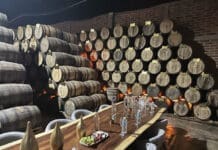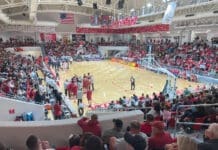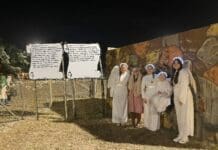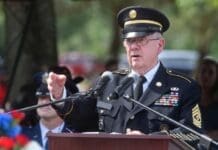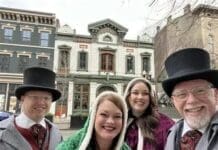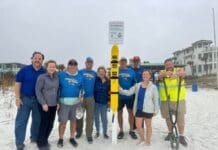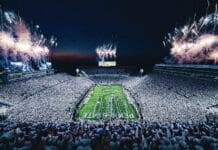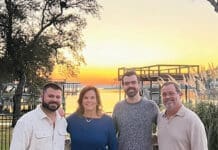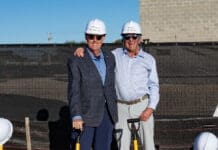By Bradley Hicks
As folks across the nation gear up to celebrate the 75th birthday of the Air Force later this summer, those at the McKinley Climatic Laboratory here recently marked the facility’s diamond anniversary. Initial testing at the MCL occurred on May 24, 1947, predating the official establishment of the Air Force by about three months.
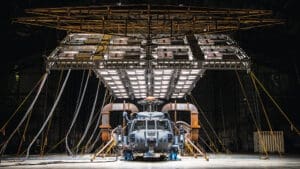
For 75 years since, the unique capabilities available at the MCL have been utilized to conduct a variety of climatic testing for the Department of Defense, other government agencies and private industry. From arctic freeze to blazing heat and desert sand to jungle humidity, any climatic environment in the world can be simulated in the facility. “For all agencies of the DOD, environmental testing at the MCL is an essential step in establishing a proven military capability to meet our global commitments specifically stated in the National Defense Strategy,” Kirk Velasco, retired MCL director, wrote in a commentary published in High Mach in 2020. “The results obtained from the vast array of aircraft and equipment tested at the MCL have been a major factor in maintaining the position of the United States as the world’s leading military power.”
Today, the MCL is managed by the 717th Test Squadron, a geographically separated unit located at Arnold Engineering Development Complex in Tennessee.
 When it first began operations, the MCL was part of the U.S. Army Air Forces. This component was soon separated from the Army and became its own military branch when the Air Force was founded on Sept. 18, 1947. Before the MCL, there was the Cold Weather Test Detachment stationed at Ladd Field in Fairbanks, Alaska. The Army Air Force designated that site as a cold-weather testing facility in 1940. Prior U.S. involvement in World War I meant that international warfare was on the table and service members could end up engaged in combat virtually anywhere on the planet. The ability of military aircraft and equipment to maintain operability and reliability in the harshest of climates needed to be ensured. This was the mission of the Cold Weather Test Detachment at Ladd Field. For two years following its 1940 activation, the detachment managed to establish basic operational and maintenance requirements for aircraft in the arctic, perform experiments on cold weather uniforms and rations, and experiment on solutions to arctic flying issues. Testing at Ladd Field ceased after the December 1941 attack on Pearl Harbor. There were concerns installations in Alaska could also come under attack. So, it was decided that all military aircraft there would be used to defend the state.
When it first began operations, the MCL was part of the U.S. Army Air Forces. This component was soon separated from the Army and became its own military branch when the Air Force was founded on Sept. 18, 1947. Before the MCL, there was the Cold Weather Test Detachment stationed at Ladd Field in Fairbanks, Alaska. The Army Air Force designated that site as a cold-weather testing facility in 1940. Prior U.S. involvement in World War I meant that international warfare was on the table and service members could end up engaged in combat virtually anywhere on the planet. The ability of military aircraft and equipment to maintain operability and reliability in the harshest of climates needed to be ensured. This was the mission of the Cold Weather Test Detachment at Ladd Field. For two years following its 1940 activation, the detachment managed to establish basic operational and maintenance requirements for aircraft in the arctic, perform experiments on cold weather uniforms and rations, and experiment on solutions to arctic flying issues. Testing at Ladd Field ceased after the December 1941 attack on Pearl Harbor. There were concerns installations in Alaska could also come under attack. So, it was decided that all military aircraft there would be used to defend the state.
The Cold Weather Test Detachment was reactivated in 1942 and by that winter, testing had resumed at Ladd Field as the importance of such efforts was recognized. However, issues present since testing initially began at Ladd Field continued to be encountered. Despite its position on the globe, cold weather testing at Ladd Field was often inconsistent.
Cold weather testing there was conducted in an open-air environment which essentially involved subjecting aircraft and equipment to the outdoors conditions. However, it was difficult to predict when temperatures would reach the levels required for testing. When they did, these temperatures would sometimes not remain low enough for long enough to meet testing needs.
Along with suggesting that U.S. aircraft be operable at minus 65 degrees Fahrenheit, then-Lt. Col. Ashley McKinley is credited for suggesting the construction of a refrigerated airplane hangar to allow for cold weather testing under controlled conditions. The headquarters for such testing was reassigned to the more temperate Eglin AFB and plans for McKinley’s suggested facility were approved in 1944. Construction began soon thereafter.
The first tests at the MCL involved subjecting a B-29 Superfortress, C-82 Packet cargo plane, P-80 Shooting Star, P-51 Mustang, P-47 Thunderbolt and R5D helicopter, as well as trucks, tanks and clothing, to a temperature of minus 70 degrees Fahrenheit. The tests were considered highly successful.
In 1971, the refrigerated hangar was dedicated as the McKinley Climatic Hangar in honor of McKinley, who passed away the previous year.
Over the years, the facility that would become known as the McKinley Climatic Laboratory expanded its offerings beyond arctic and subarctic testing. The laboratory now consists of five testing chambers used to prove the operational reliability of systems under test in the climatic extremes found around the world. Along with large aircraft, items tested within these chambers include engines, tanks, missile launchers, shelters and automobiles. “The MCL is the only facility in the world that can hold and test a full-scale operational aircraft in climatic extremes,” said Melissa Tate, MCL site director. “This facility can produce, on any given day, any extreme weather environment within which to conduct a desired test.”
Examples of aircraft more recently tested at the MCL include the F-117A Nighthawk Stealth Fighter, C-130J Super Hercules, F-22 Raptor, F-16 Fighting Falcon, B-2 Spirit bomber and the HH-60W Jolly Green II combat search and rescue helicopter.
In 1987, the MCL was named a National Historic Mechanical Engineering Landmark by the American Society of Mechanical Engineers. The following decade, it was added to the National Register of Historic Places. “It’s pretty awesome that MCL is the only facility on the planet that can do what we do,” said Michael Burch, MCL senior facility field engineer, who has been employed at the laboratory for nearly 25 years.
Editorial note: This article includes information from the National Park Service itinerary “Aviation: From Sand Dunes to Sonic Booms,” an American Society of Mechanical Engineers brochure on the MCL and an Army study titled “Cold Weather Testing in Alaska: 1940-1970.”







